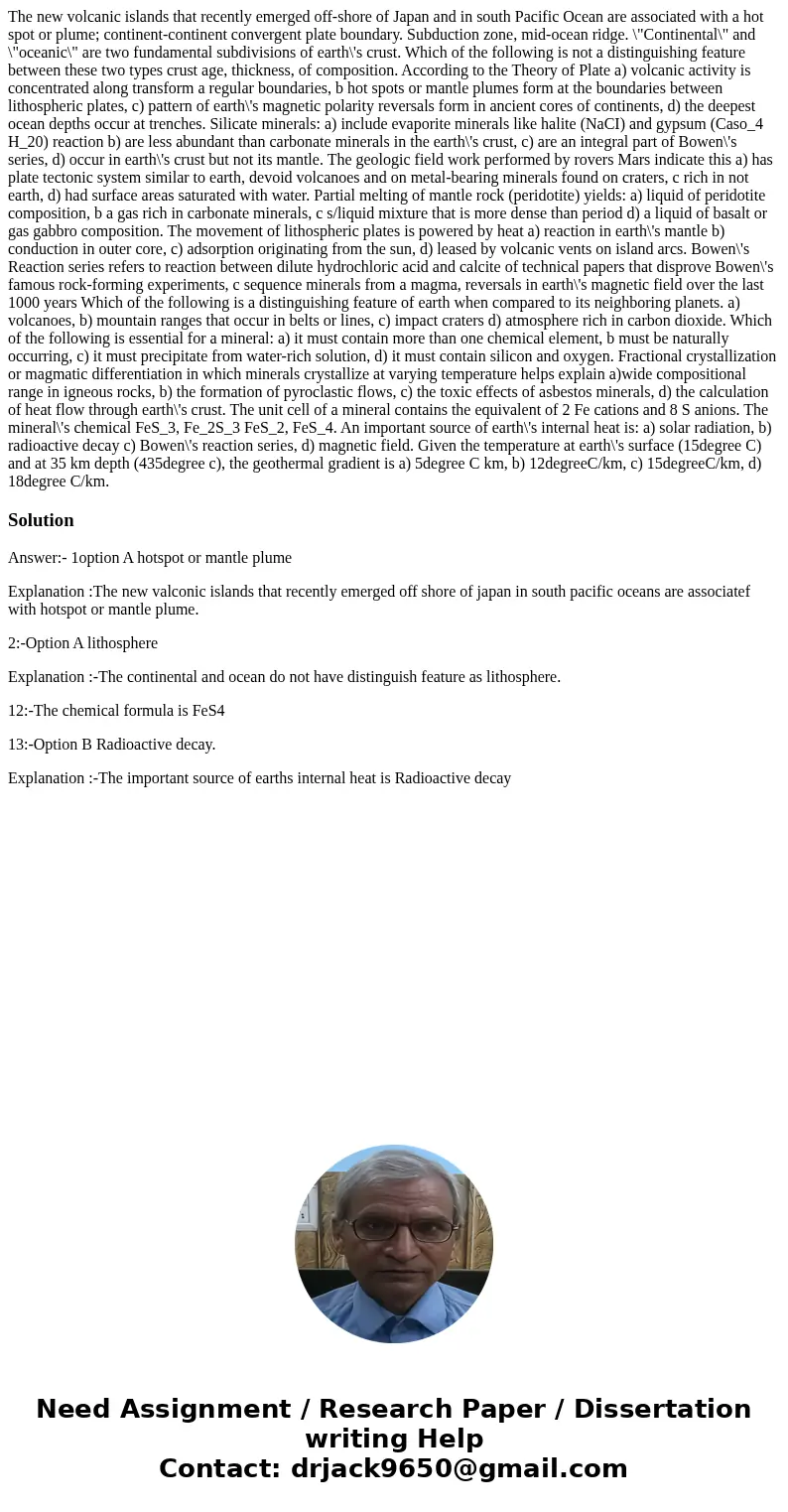The new volcanic islands that recently emerged offshore of J
The new volcanic islands that recently emerged off-shore of Japan and in south Pacific Ocean are associated with a hot spot or plume; continent-continent convergent plate boundary. Subduction zone, mid-ocean ridge. \"Continental\" and \"oceanic\" are two fundamental subdivisions of earth\'s crust. Which of the following is not a distinguishing feature between these two types crust age, thickness, of composition. According to the Theory of Plate a) volcanic activity is concentrated along transform a regular boundaries, b hot spots or mantle plumes form at the boundaries between lithospheric plates, c) pattern of earth\'s magnetic polarity reversals form in ancient cores of continents, d) the deepest ocean depths occur at trenches. Silicate minerals: a) include evaporite minerals like halite (NaCI) and gypsum (Caso_4 H_20) reaction b) are less abundant than carbonate minerals in the earth\'s crust, c) are an integral part of Bowen\'s series, d) occur in earth\'s crust but not its mantle. The geologic field work performed by rovers Mars indicate this a) has plate tectonic system similar to earth, devoid volcanoes and on metal-bearing minerals found on craters, c rich in not earth, d) had surface areas saturated with water. Partial melting of mantle rock (peridotite) yields: a) liquid of peridotite composition, b a gas rich in carbonate minerals, c s/liquid mixture that is more dense than period d) a liquid of basalt or gas gabbro composition. The movement of lithospheric plates is powered by heat a) reaction in earth\'s mantle b) conduction in outer core, c) adsorption originating from the sun, d) leased by volcanic vents on island arcs. Bowen\'s Reaction series refers to reaction between dilute hydrochloric acid and calcite of technical papers that disprove Bowen\'s famous rock-forming experiments, c sequence minerals from a magma, reversals in earth\'s magnetic field over the last 1000 years Which of the following is a distinguishing feature of earth when compared to its neighboring planets. a) volcanoes, b) mountain ranges that occur in belts or lines, c) impact craters d) atmosphere rich in carbon dioxide. Which of the following is essential for a mineral: a) it must contain more than one chemical element, b must be naturally occurring, c) it must precipitate from water-rich solution, d) it must contain silicon and oxygen. Fractional crystallization or magmatic differentiation in which minerals crystallize at varying temperature helps explain a)wide compositional range in igneous rocks, b) the formation of pyroclastic flows, c) the toxic effects of asbestos minerals, d) the calculation of heat flow through earth\'s crust. The unit cell of a mineral contains the equivalent of 2 Fe cations and 8 S anions. The mineral\'s chemical FeS_3, Fe_2S_3 FeS_2, FeS_4. An important source of earth\'s internal heat is: a) solar radiation, b) radioactive decay c) Bowen\'s reaction series, d) magnetic field. Given the temperature at earth\'s surface (15degree C) and at 35 km depth (435degree c), the geothermal gradient is a) 5degree C km, b) 12degreeC/km, c) 15degreeC/km, d) 18degree C/km.
Solution
Answer:- 1option A hotspot or mantle plume
Explanation :The new valconic islands that recently emerged off shore of japan in south pacific oceans are associatef with hotspot or mantle plume.
2:-Option A lithosphere
Explanation :-The continental and ocean do not have distinguish feature as lithosphere.
12:-The chemical formula is FeS4
13:-Option B Radioactive decay.
Explanation :-The important source of earths internal heat is Radioactive decay

 Homework Sourse
Homework Sourse